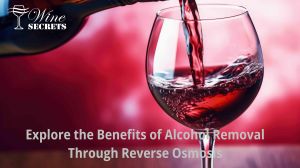
Introduction:
The topic of non-alcoholic wine garnered significant attention at the Unified Wine Symposium 2024, indicative of its growing popularity. According to NielsenIQ, sales of nonalcoholic beverages, including beer, wine, and spirits, witnessed a 20.6% increase from August 2021 to 2022 in the U.S. [source: WBAY]. Projections suggest a substantial surge in global demand for non-alcoholic wine, expected to grow at a CAGR of 10% from 2023 to 2033. Presently, the global market for non-alcoholic wine stands at US $2 billion and is anticipated to reach US $5.2 billion by 2033. [source: factmr]
For over two decades, Winesecrets has been at the forefront of adjusting alcohol levels in wine, pioneering the process of dealcoholizing wine since its inception in 2003. Formerly known as Vinovation, Winesecrets introduced the innovative method of using reverse osmosis for alcohol removal from wine, continuously refining the process over the years.
Methods of Wine Alcohol Removal:
There are three primary methods for wine alcohol removal. Firstly, wines undergo full fermentation, resulting in fully finished wine, after which the alcohol is removed. This elaborate process might contribute to the perception that dealcoholized wine is less economical compared to traditional wine.
The method initially developed by Vinovation (now Winesecrets), known as Reverse Osmosis, or filtration, is widely employed in dealcoholizing wine. In this process, wine is pressurized through a membrane, separating alcohol and water. The resultant mixture (permeate) consists of water and alcohol, while the concentrated wine, devoid of alcohol and with reduced water content, remains behind. The water-alcohol mixture is then heated to evaporate the alcohol, and the remaining water is reintroduced into the wine. When processing to result in a non-alcoholic wine, the permeate (water- alcohol mixture) is discarded and replaced with RO water. That process is repeated, usually 3 times, until the wine reaches below the TTB threshold of 0.50% and qualifies as a non-alcoholic product.
Reverse Osmosis:
Pros:
- Most commonly utilized method.
- Operates at low temperatures (around 8-10°C) [source: Bevzero].
- Allows incremental alcohol reduction.
- No heat is involved in the process.
- At Winesecrets we can do bench trial sizes to know the results before running the full production size
Cons:
- Incremental alcohol reduction may require multiple passes.
- Loss of volatile aroma compounds through the membrane [source: Bevzero].
- Slower compared to other methods.
- Removed alcohol cannot be reused [source: VinePair].
Debunking Misconceptions:
- Challenge the notion of significant aroma loss, emphasizing lower operating temperatures (60°F) [source: VinePair].
- Clarify the rate of alcohol removal (typically 4 passes for a 15% wine to reach 3%) [source: Bevzero].
Vacuum Distillation:
In this method, wine is heated in a vacuum, causing alcohol to evaporate at temperatures ranging from 70-95°F. Aromatics are then reintroduced into the wine post-distillation.
Pros:
- Preserves more flavor and aroma compared to high-temperature boiling.
- Alcohol can be reduced to very low levels (<0.5% – <0.02% ABV) [source: The Daily Meal].
Cons:
- Involves multiple steps in the process [source: The Daily Meal].
- Heat utilized may lead to flavor breakdown.
- Requires processing large batches due to the absence of trial sizes.
Spinning Cone Method:
This technique involves spinning wine at high speeds within a column of cones to isolate volatile components. Nitrogen gas is introduced to remove flavors, aromas, and other components, followed by the addition of water and alcohol back into the wine.
Pros:
- Effectively preserves flavors and aromas [source: Food & Wine].
Cons:
- Heat used may cause flavor degradation.
- Similar to vacuum distillation, no trial sizes are available, necessitating processing of large batches.
Conclusion:
Dealcoholizing wine is a meticulous process that demands careful consideration of the method employed to ensure preservation of flavor and aroma. Despite misconceptions, various techniques such as Reverse Osmosis, Vacuum Distillation, and the Spinning Cone Method offer viable options for producing high-quality non-alcoholic wine. Selecting the appropriate method is crucial in maintaining the integrity and sensory appeal of the final product.
The journey towards crafting exceptional non-alcoholic wine is paved with innovation and precision. With its pioneering legacy, Winesecrets’ predecessor, Vinnovation, revolutionized the art of dealcoholizing wine through reverse osmosis. What sets us apart is our commitment to offering winemakers a unique opportunity: a small bench trial run to assess the results before committing to full-scale production. This unparalleled approach minimizes risks, ensuring that the final product aligns perfectly with the winemaker’s discerning palate. Trust in Winesecrets to unlock the full potential of your non-alcoholic wine, where quality and taste always take center stage.
Call us today to book your bench trial! 888-656-5553
References (listed in order):
- WBAY: https://www.wbay.com/2023/12/29/behind-boom-low-alcohol-non-alcoholic-drinks/
- Factmr: https://www.factmr.com/report/4532/non-alcoholic-wine-market
- Bevzero: https://bevzero.com/choosing-dealcoholization-method/
- VinePair: https://vinepair.com/articles/everything-you-need-to-know-about-alcohol-free-wine/
- The Daily Meal: https://www.thedailymeal.com/1320109/non-alcoholic-wine-grape-juice-difference/
- Food & Wine: https://www.foodandwine.com/dealcoholized-wine-7495131

